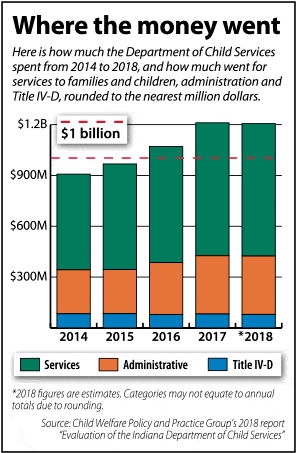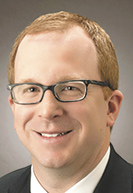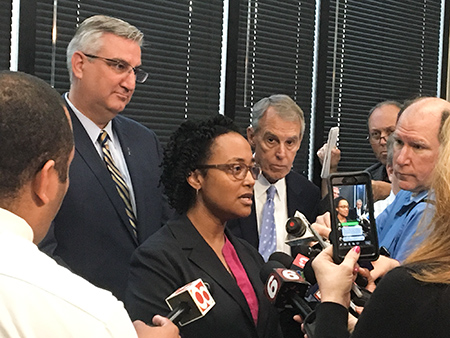Subscriber Benefit
As a subscriber you can listen to articles at work, in the car, or while you work out. Subscribe NowWhen Gov. Eric Holcomb announced last week he was releasing $25 million from the state’s Rainy Day Fund for the Indiana Department of Child Services, the auditorium filled with family case managers, supervisors and government officials burst into applause before he could finish his statement.
“Wait till you hear the details,” the governor teased.
Holcomb and DCS executive director Terry Stigdon unveiled the findings and recommendations of an eagerly awaited evaluation of the agency by the Child Welfare Policy and Practice Group. Following a PowerPoint presentation by CWG director Paul Vincent, Holcomb said his administration would be implementing the changes suggested by the consultants. To get the process started, he was dipping into the state budget surplus.
However, the $25 million is not the first infusion of extra money given to DCS in recent years. In fact, this is one of the smaller supplements to the department’s annual state appropriation, which is more than $600 million.
 According to the CWG analysis, total DCS spending rose from $907.9 million in fiscal year 2014 to an estimated $1.21 billion in fiscal year 2018, which ends June 30. The increase is driven by the dollars needed to provide services to families and children. Spending for services is expected to be $781.5 million while administrative costs will consume about $348.5 million in the current fiscal year.
According to the CWG analysis, total DCS spending rose from $907.9 million in fiscal year 2014 to an estimated $1.21 billion in fiscal year 2018, which ends June 30. The increase is driven by the dollars needed to provide services to families and children. Spending for services is expected to be $781.5 million while administrative costs will consume about $348.5 million in the current fiscal year.
CWG is anticipating services expenses in 2018 will actually be $3 million lower than the $784.5 million spent in fiscal year 2017. This corresponds to the decline in open cases being handled by DCS statewide. The consultants found the number of children who are receiving services peaked in May 2017 at 29,280 and has since fallen to 26,595 in May 2018.
The rise in spending does not surprise Sharon Pierce, CEO of The Villages of Indiana, the largest nonprofit child and family service agency with 20 offices around the state. Pointing to the CWG report, she noted the number of children being served by DCS has doubled in the last five years, which means additional funds will be need to provide the care.
“There are more mouths to feed because there are more mouths to feed,” Pierce said.
DCS did not respond to requests for additional information.
Increases and augmentations
Holcomb did not provide specifics as to how the $25 million would be used, but he did say a portion would go toward raises for DCS workers.
In its study of the Department of Child Services, CWG said family case managers and supervisors said their salaries were “not commensurate with the high levels of stress, legal liability, and expectations of overtime and on-call work that characterize their jobs.” Annual pay ranges from $35,776 to $64,974.
Yet even before the governor announced the injection of surplus money, DCS’s budget had already been increased by $50 million for fiscal year 2019, beginning July 1, 2018. And this is not the first time additional funds have had to be given to the agency over and above its annual appropriation.
From fiscal years 2014 through 2017, according to the CWG report and state records, the Indiana General Assembly budgeted an annual appropriation of just over $550 million. But in 2017, the state had to augment DCS’ funding by $136.7 million. For fiscal year 2018, the agency needed an augmentation of $284 million, even though its annual appropriation had been boosted to $629 million.
 Dudich
DudichIndiana Rep. Gregory Porter, D-Indianapolis, blasted DCS for overspending its budget and asserted “overages are financed by siphoning funds” from the state’s Medicaid and Temporary Assistance for Needy Families (TANF) programs. He is concerned that families depending on these programs will not be getting the services they need because the money has been shifted to DCS.
Jason Dudich, director of the State Budget Agency, disputed Porter’s claim.
He said $250 million of the fiscal year 2018 augmentation was from the state’s general fund. Indiana, he explained, had a surplus of TANF dollars and it directed those extra funds to cover spending within student financial aid, which is eligible to receive TANF money. By shifting the TANF surplus to financial aid, a quarter-billion dollars in the state’s general fund was freed, so that was transferred to DCS in fiscal year 2018.
The remaining $34 million of the $284 million augmentation came from a general fund surplus of $74 million that was shifted to Medicaid at the end of fiscal year 2017 to cover certain issues including DCS, Dudich said. Those dollars, he continued, help cover health care costs for the children who are in DCS and eligible for Medicaid.
Porter is not convinced by the explanation. “They look at it from a different perspective to make it look better,” he said.
The Representative is also frustrated that DCS has not indicated how much more money it will need. He said he has asked the question repeatedly but the agency never answers, which, he believes, is because it does not really know.
“Hopefully, as time goes on,” Porter said, “we can get a handle on what is really needed to run the agency effectively and efficiently.”
More mouths
The increase in youngsters entering the child welfare system has been seen as directly linked to the rise in substance abuse and addiction in Indiana. According to the CWG report, children removed from their home because of parental drug use has risen from 39.1 percent in fiscal year 2014 to 55.6 percent in fiscal year 2017.
More than increasing the number of children in need, the drug epidemic is also creating a need for a higher level of therapeutic services. Pierce said the cases of neglect and abuse are more severe when the parents are in the grip of an addiction. So an extra effort is required to help heal these children of emotional and physical malnutrition.
“Our goal, as a partner with DCS, is to do everything we can to minimize the trauma these children experience because their parents are unable, at least right now, to care for them,” Pierce said. Overall from September 2005 to September 2017, the number of Indiana children in out-of-home care increased 89.4 percent, according to the CWG analysis.
The primary reason for removing young Hoosiers from their home is neglect which, CWG pointed out, is often associated with parental substance abuse. During the 2017 fiscal year, 77 percent of the children removed were taken from their families because of neglect. This compares to 51 percent in fiscal year 2013.
However, CWG noted Indiana’s definition of “neglect” is broader than that used by surrounding states. The consultants recommended Hoosiers re-examine the term and possibly redefine the word to “exclude neglect that is based solely on poverty or limited, one-time lapses in parental judgment.”
‘Our tsunami’
Regardless of whether Indiana reconsiders what “neglect” means, at present, the number of children in the system need services, and that requires money.
Nonprofit agencies around the state, such as The Villages, partner with DCS by providing services such as recruiting and training foster families along with offering the counseling and treatment for the children. These organizations do not negotiate a contract but rather are paid a set rate by the state, Pierce said.
Over the past five years, she said, these rates have remained flat, creating a financial strain on the nonprofits because their own costs have risen. In addition, the per diem paid to foster families which, according to CWG, ranges from $20.53 to $33.49 depending on the age of the child and services needed, is not covering all the household’s expenses related to caring for the foster children.
Most notably, Pierce said, foster families are struggling to pay for child care for their foster children. Her organization has amped up its fundraising in order to “stand in the gap” and keep the foster homes stable.
The donations are helping The Villages achieve its goal of putting foster children with families who match their ethnic, racial and spiritual backgrounds, and keeping them in that home until they are either reunited with their biological parents or adopted. Along with helping cover day care costs, the nonprofit helps foster families with the purchase of extra cribs or car seats so siblings can be placed together.
Pierce is proud that Holcomb is drawing money from the state’s Rainy Day Fund and is hopeful some of the $25 million will be directed to service providers such as The Villages. The surplus, she said, is supposed to be used for emergencies when families need help.
“This is our tsunami,” she said of the children in crisis. “This is our natural disaster.”•
Please enable JavaScript to view this content.

